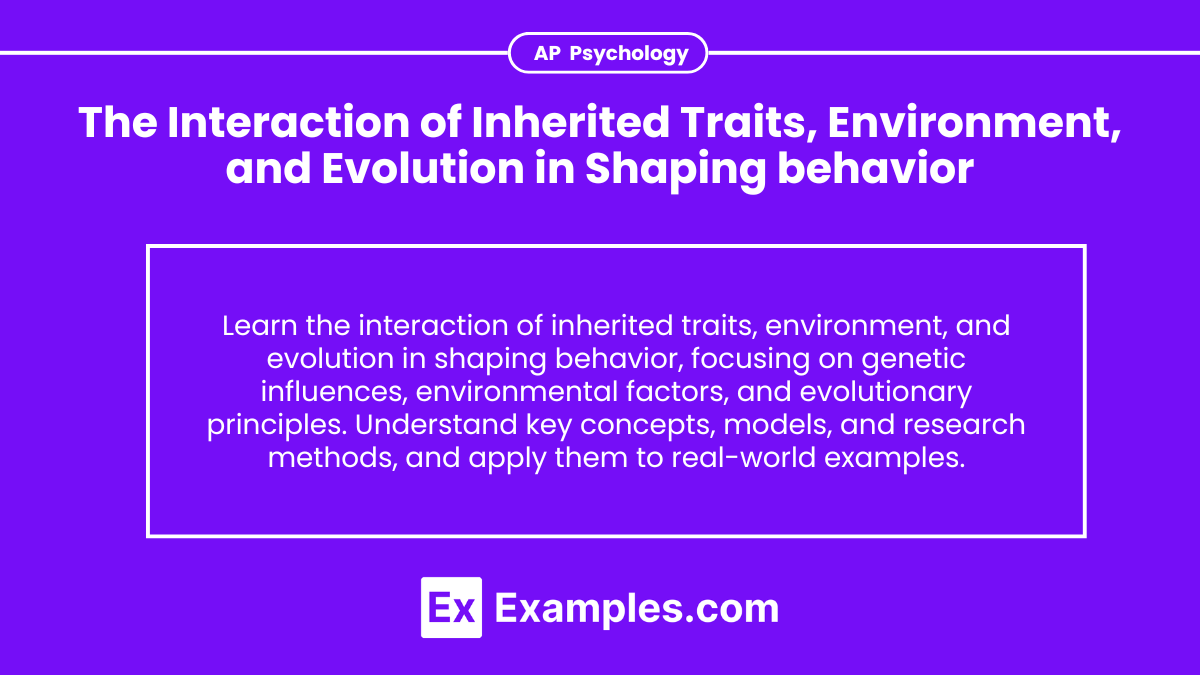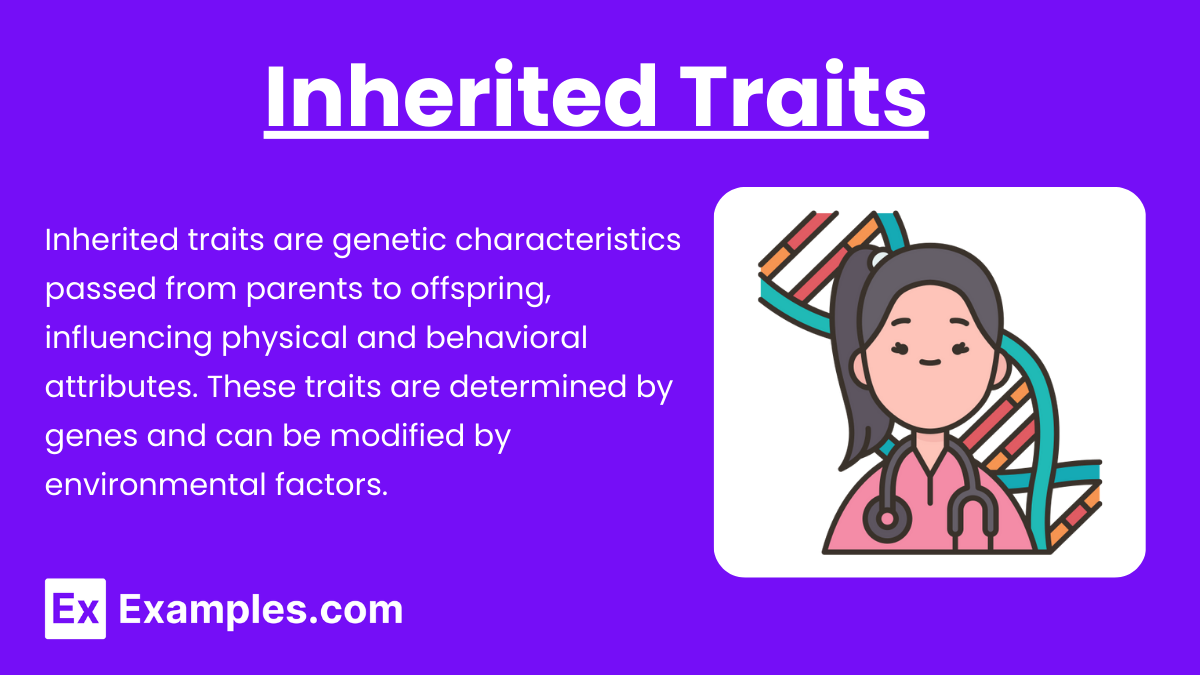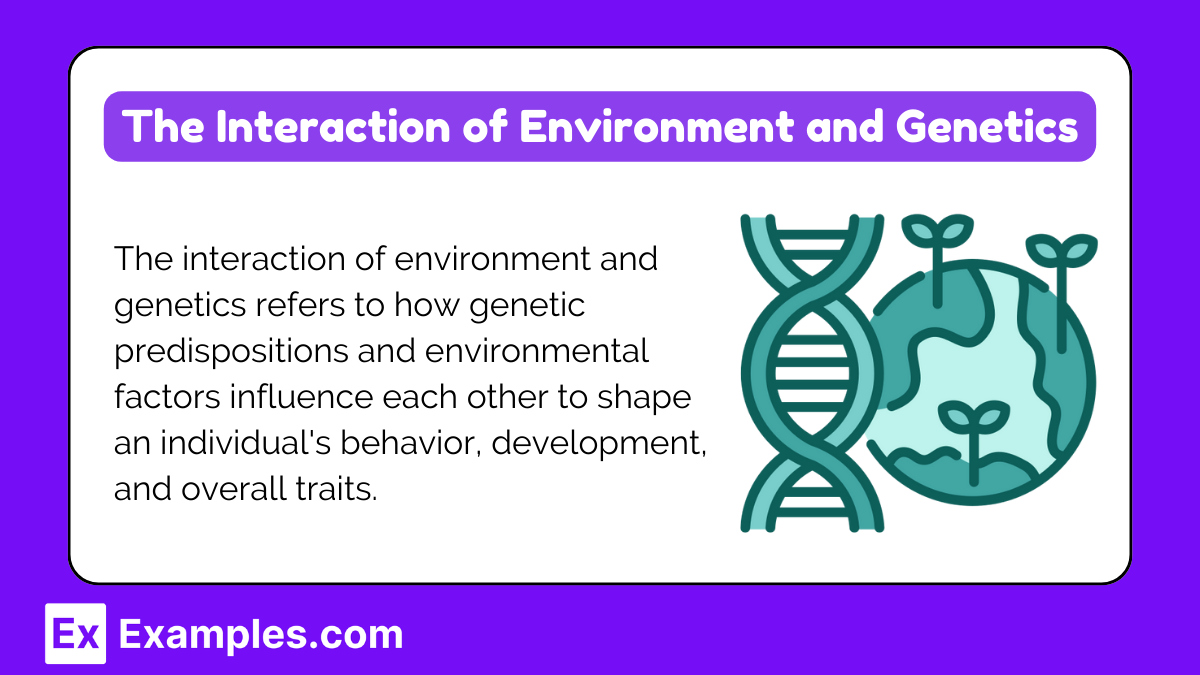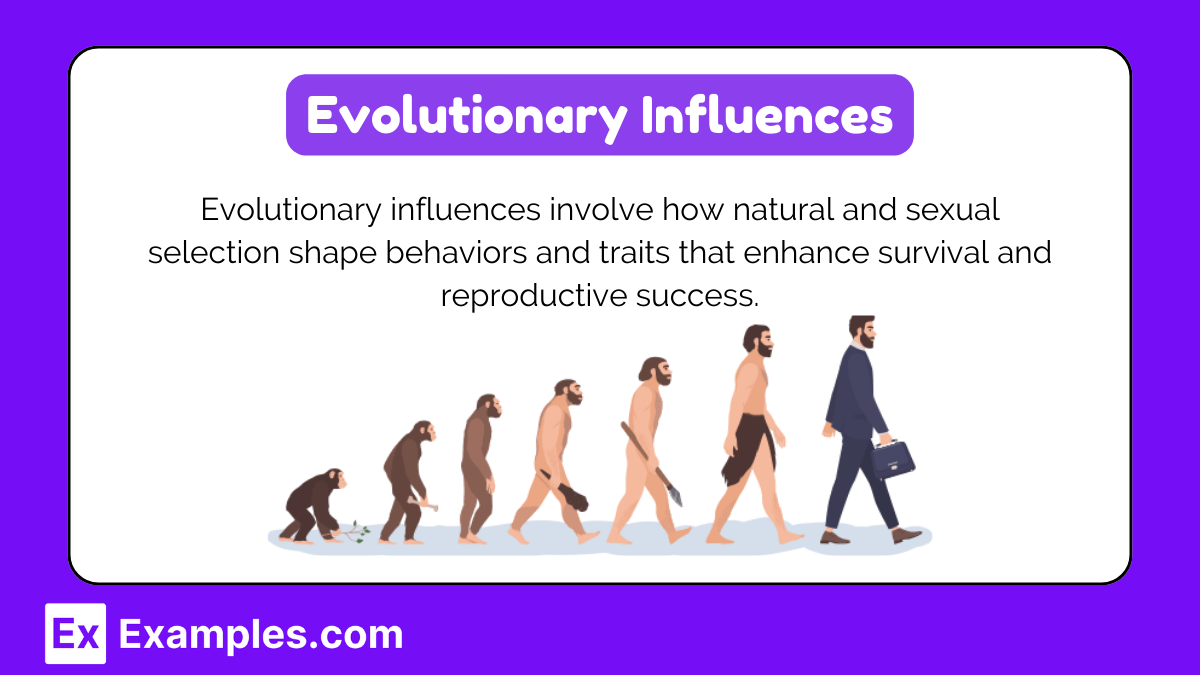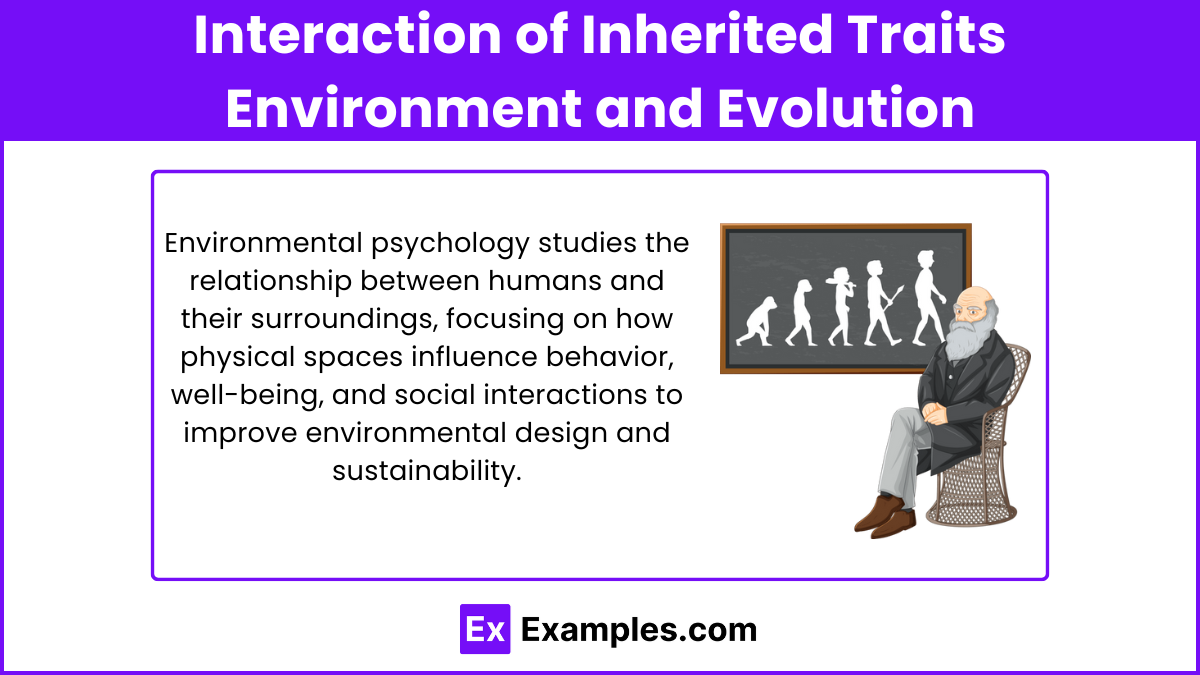The interaction of inherited traits, environment, and evolution significantly shapes behavior, a key topic in AP Psychology. Genetic factors provide the foundation for potential traits, while environmental influences like family, culture, and peer interactions mold their expression. Evolutionary principles, such as natural and sexual selection, help explain why certain behaviors persist. This dynamic interplay highlights the complexity of human behavior, emphasizing the need for a comprehensive understanding of both biological and environmental contributions in psychology.
Learning Objectives
For the AP Psychology exam, focus on understanding how inherited traits (genes and heritability), environmental influences (prenatal conditions, family, culture, and peers), and evolutionary factors (natural and sexual selection, adaptive behaviors) interact to shape behavior. Study key models like the diathesis-stress model and differential susceptibility model, and review research methods such as twin and adoption studies. Be able to apply these concepts to real-world examples and explain their practical implications in psychology, education, and healthcare.
1. Inherited Traits
Inherited traits are characteristics passed from parents to offspring through genes. These traits can be physical, such as eye color and height, or behavioral, such as temperament and intelligence. The study of how these traits are transmitted from one generation to the next falls under the field of genetics.
Genetic Basis of Inherited Traits
Genes and Chromosomes
Genes: Segments of DNA that contain the instructions for making proteins. These proteins influence how cells function and contribute to the development of traits.
Chromosomes: Structures within cells that contain a person's genes. Humans have 23 pairs of chromosomes, with one set inherited from each parent.
Genotype and Phenotype
Genotype: The genetic makeup of an individual, comprising all the genes inherited from both parents.
Phenotype: The observable characteristics of an individual, resulting from the interaction of the genotype with the environment.
Mechanisms of Inheritance
Dominant and Recessive Alleles
Alleles: Different forms of a gene. Each individual inherits two alleles for each gene, one from each parent.
Dominant Alleles: Only one copy is needed for the trait to be expressed.
Recessive Alleles: Two copies are needed for the trait to be expressed.
Mendelian Inheritance
Mendelian Inheritance: Patterns of inheritance first described by Gregor Mendel. Key principles include:
Law of Segregation: Each parent contributes one of two possible alleles for a trait.
Law of Independent Assortment: Genes for different traits are inherited independently of each other.
Polygenic Inheritance
Polygenic Inheritance: Traits influenced by multiple genes, often resulting in a continuous range of possible phenotypes. Examples include height, skin color, and intelligence.
2. Environmental Influences
Environmental influences play a crucial role in shaping behavior and development. These influences encompass all external factors, from prenatal conditions to cultural and societal norms, that impact an individual throughout their life.
Types of Environmental Influences
Prenatal Environment
The prenatal environment refers to the conditions within the womb before birth. Factors during this period can significantly affect development and behavior.
Nutrition: Adequate maternal nutrition is essential for proper fetal development. Deficiencies can lead to developmental issues.
Teratogens: Harmful substances such as alcohol, drugs, and toxins can cause congenital disabilities and developmental disorders.
Stress: Maternal stress can affect fetal development, potentially leading to behavioral and emotional problems later in life.
Family Environment
The family environment includes the dynamics, relationships, and socioeconomic conditions within the family unit.
Parenting Styles: Different parenting styles (authoritative, authoritarian, permissive, and uninvolved) can shape a child's behavior, self-esteem, and social skills.
Socioeconomic Status: Family income and education levels can impact access to resources, educational opportunities, and overall development.
Home Environment: Stability, warmth, and stimulation within the home contribute to cognitive and emotional development.
Peer Influence
Peers play a significant role in shaping behavior, particularly during childhood and adolescence.
Socialization: Interaction with peers helps develop social skills, norms, and values.
Peer Pressure: Can lead to the adoption of behaviors and attitudes to fit in or gain acceptance.
Friendships: Positive friendships can support emotional well-being and social development.
Educational Environment
Schools and educational settings provide critical contexts for cognitive and social development.
Teacher Expectations: High expectations from teachers can motivate students and enhance academic achievement.
School Climate: A positive and inclusive school environment fosters learning and personal growth.
Extracurricular Activities: Participation in sports, arts, and clubs can develop skills, interests, and social connections.
Cultural Environment
Culture shapes behavior through norms, values, and expectations transmitted across generations.
Cultural Norms: Influence behaviors, traditions, and societal roles.
Language and Communication: Language shapes thought processes and communication styles.
Cultural Practices: Rituals, celebrations, and customs provide a sense of identity and belonging.
Societal Influences
Broader societal factors also impact behavior and development.
Media and Technology: Exposure to media and technology influences behavior, attitudes, and knowledge.
Economic Conditions: Economic stability or instability can affect access to resources and opportunities.
Political Climate: Government policies and societal structures can impact education, healthcare, and social services.
3. The Interaction of Environment and Genetics
The interaction between genetic predispositions and environmental factors is complex. Both nature and nurture work together to shape behavior.
Gene-Environment Interaction
Genetic Predisposition: Individuals may have a genetic susceptibility to certain traits or behaviors.
Environmental Triggers: Environmental factors can activate or suppress genetic tendencies.
Epigenetics: Environmental influences can alter gene expression without changing the DNA sequence, affecting behavior and development.
Gene-Environment Correlation
Passive Correlation: Parents provide both genes and environment, influencing behavior.
Evocative Correlation: An individual’s genetic traits evoke specific responses from the environment.
Active Correlation: Individuals actively seek environments that complement their genetic predispositions.
4. Evolutionary Influences
Evolutionary psychology explores how natural selection has shaped behavior over time. It examines how adaptive traits and behaviors that enhance survival and reproduction are passed down through generations.
Key Concepts in Evolutionary Psychology
Natural Selection
Natural Selection: The process where traits that enhance survival and reproduction become more common in successive generations.
Survival of the Fittest: Individuals with advantageous traits are more likely to survive and reproduce.
Adaptive Traits: Traits that increase an organism's chances of survival and reproduction.
Sexual Selection
Sexual Selection: A form of natural selection where traits that enhance mating success are favored.
Intersexual Selection: Traits that attract the opposite sex (e.g., peacock's tail).
Intrasexual Selection: Traits that increase success in same-sex competition for mates (e.g., antlers on deer).
Evolutionary Explanations for Human Behavior
Aggression
Evolutionary Perspective on Aggression: Aggression may have evolved as a means to secure resources, protect offspring, and gain social status.
Intrasexual Competition: Competition within the same sex for mates can lead to aggressive behaviors.
Mating Strategies
Short-term vs. Long-term Mating: Different strategies may be employed depending on the individual's circumstances and reproductive goals.
Male Strategies: May prioritize short-term mating opportunities to maximize reproductive success.
Female Strategies: May prioritize long-term mating to ensure resource provision and offspring care.
Parenting
Parental Investment Theory: The investment parents make in their offspring influences mating behaviors and strategies.
Maternal Investment: Typically higher due to pregnancy, childbirth, and nursing.
Paternal Investment: Can vary, often depending on certainty of paternity and availability of resources.
Social Behavior
Group Living: Evolved to enhance survival through cooperation, shared resources, and collective defense.
Social Hierarchies: Establish order and reduce conflict within groups.
Altruism: Behaviors that benefit others at a cost to oneself can enhance group cohesion and survival.
Evolutionary Adaptations
Evolutionary psychology focuses on how certain behaviors and psychological mechanisms have evolved to solve specific problems of survival and reproduction.
5. Interaction of Inherited Traits, Environment, and Evolution
Behavior results from the dynamic interaction between genetic predispositions, environmental factors, and evolutionary pressures.
Key Concepts:
Epigenetics: Environmental factors can alter gene expression without changing the DNA sequence.
Gene-Environment Interaction: Specific environments can influence the expression of certain genes.
Gene-Environment Correlation: Individuals with certain genetic predispositions may seek out specific environments.
Models of Interaction
Diathesis-Stress Model
Diathesis-Stress Model: Suggests that psychological disorders develop due to a combination of genetic vulnerability and environmental stressors.
Diathesis: Genetic predisposition.
Stress: Environmental triggers.
Differential Susceptibility Model
Differential Susceptibility Model: Proposes that individuals vary in their sensitivity to environmental influences based on genetic factors.
Orchid Children: Highly sensitive to both positive and negative environments.
Dandelion Children: More resilient to varying environmental conditions.
Research and Studies
Twin Studies
Twin Studies: Examine the relative contributions of genetics and environment by comparing identical and fraternal twins.
Identical Twins: Share 100% of their genes.
Fraternal Twins: Share about 50% of their genes.
Adoption Studies
Adoption Studies: Compare adopted children to their biological and adoptive parents to understand the influence of genetics and environment.

